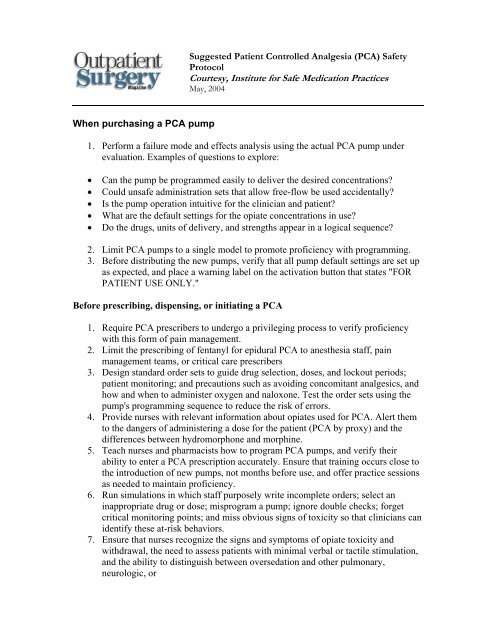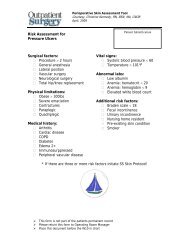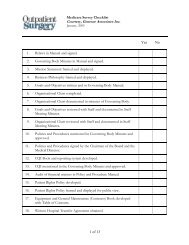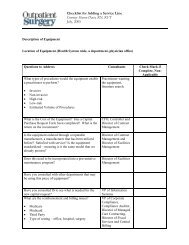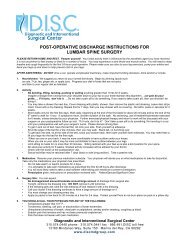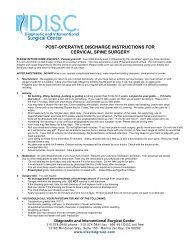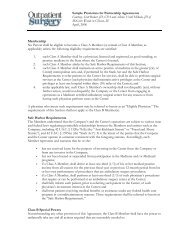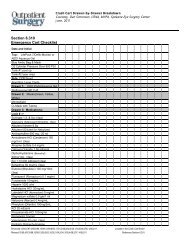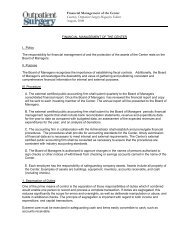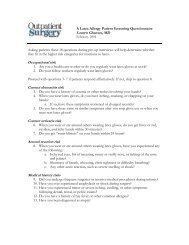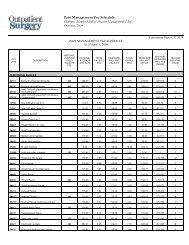Patient-Controlled Analgesia (PCA) - Outpatient Surgery Magazine
Patient-Controlled Analgesia (PCA) - Outpatient Surgery Magazine
Patient-Controlled Analgesia (PCA) - Outpatient Surgery Magazine
You also want an ePaper? Increase the reach of your titles
YUMPU automatically turns print PDFs into web optimized ePapers that Google loves.
Suggested <strong>Patient</strong> <strong>Controlled</strong> <strong>Analgesia</strong> (<strong>PCA</strong>) SafetyProtocolCourtesy, Institute for Safe Medication PracticesMay, 2004When purchasing a <strong>PCA</strong> pump1. Perform a failure mode and effects analysis using the actual <strong>PCA</strong> pump underevaluation. Examples of questions to explore:• Can the pump be programmed easily to deliver the desired concentrations?• Could unsafe administration sets that allow free-flow be used accidentally?• Is the pump operation intuitive for the clinician and patient?• What are the default settings for the opiate concentrations in use?• Do the drugs, units of delivery, and strengths appear in a logical sequence?2. Limit <strong>PCA</strong> pumps to a single model to promote proficiency with programming.3. Before distributing the new pumps, verify that all pump default settings are set upas expected, and place a warning label on the activation button that states "FORPATIENT USE ONLY."Before prescribing, dispensing, or initiating a <strong>PCA</strong>1. Require <strong>PCA</strong> prescribers to undergo a privileging process to verify proficiencywith this form of pain management.2. Limit the prescribing of fentanyl for epidural <strong>PCA</strong> to anesthesia staff, painmanagement teams, or critical care prescribers3. Design standard order sets to guide drug selection, doses, and lockout periods;patient monitoring; and precautions such as avoiding concomitant analgesics, andhow and when to administer oxygen and naloxone. Test the order sets using thepump's programming sequence to reduce the risk of errors.4. Provide nurses with relevant information about opiates used for <strong>PCA</strong>. Alert themto the dangers of administering a dose for the patient (<strong>PCA</strong> by proxy) and thedifferences between hydromorphone and morphine.5. Teach nurses and pharmacists how to program <strong>PCA</strong> pumps, and verify theirability to enter a <strong>PCA</strong> prescription accurately. Ensure that training occurs close tothe introduction of new pumps, not months before use, and offer practice sessionsas needed to maintain proficiency.6. Run simulations in which staff purposely write incomplete orders; select aninappropriate drug or dose; misprogram a pump; ignore double checks; forgetcritical monitoring points; and miss obvious signs of toxicity so that clinicians canidentify these at-risk behaviors.7. Ensure that nurses recognize the signs and symptoms of opiate toxicity andwithdrawal, the need to assess patients with minimal verbal or tactile stimulation,and the ability to distinguish between oversedation and other pulmonary,neurologic, or
Suggested <strong>Patient</strong> <strong>Controlled</strong> <strong>Analgesia</strong> (<strong>PCA</strong>) SafetyProtocolCourtesy, Institute for Safe Medication PracticesMay, 20047. Require a pharmacist to review all <strong>PCA</strong> orders before initiation (exception:when a pharmacist is not on site) and suggest dose adjustments or an alternativeopiate when appropriate.8. Use "tall man" lettering on pharmacy-applied labels for HYDROmorphone tohelp avoid confusion with morphine.9. Alert clinicians to potential drug shortages with <strong>PCA</strong> opiates and, if encountered,recommend an alternative drug with clear dosing instructions.When initiating <strong>PCA</strong>1. Check patient allergies, which should be visible on the medication administrationrecord (MAR), before initiating <strong>PCA</strong>.2. Connect <strong>PCA</strong> to a port close to the patient (to avoid dead space) and prominentlylabel the infusion line at this connection to avoid mix-ups with other lines.3. Provide laminated instructions for programming <strong>PCA</strong> pumps for reference bynurses who may infrequently initiate <strong>PCA</strong>.4. Require two clinicians to independently double-check the patient's identification,drug and concentration, <strong>PCA</strong> pump settings, and the line attachment before use(and before pump refill or programming change). <strong>Patient</strong>side bar-coding can beused to verify the patient and drug/concentration; however, pump settings maystill require an independent double check.5. Avoid nurse-controlled <strong>PCA</strong> unless special monitoring is in place.6. Verify <strong>PCA</strong> settings each shift, immediately after receiving report.7. Avoid administering concomitant opiates (an alert should appear on the MAR).8. Have oxygen and naloxone readily available when initiating the device.9. Educate patients about the proper use of <strong>PCA</strong> before initiation. Start during thepreoperative testing visit so patients are not too groggy to understand. Warnfamily members and visitors about the danger of <strong>PCA</strong>-by-proxy.When monitoring the effects of <strong>PCA</strong>1. Establish a standard measurement scale to assess the patient's level of pain.2. Develop monitoring requirements for patients who are receiving <strong>PCA</strong> and bealert for signs of oversedation. At a minimum, evaluate the patient's level of pain,alertness, and vital signs, including rate and quality of respirations, every 4 hours.3. Evaluate all patients with minimal verbal and tactile stimulation to obtain anaccurate assessment of their level of sedation.4. Monitor patients more frequently during the first 24 hours and at night, whenhypoventilation and nocturnal hypoxia may occur.
Suggested <strong>Patient</strong> <strong>Controlled</strong> <strong>Analgesia</strong> (<strong>PCA</strong>) SafetyProtocolCourtesy, Institute for Safe Medication PracticesMay, 20045. Establish risk factors that could increase respiratory depression (e.g., obesity orlow body weight, concomitant medications that potentiate opiates, preexistingconditions such as asthma and sleep apnea) and determine the level of enhancedmonitoring that would be required if these patients use <strong>PCA</strong> (e.g., capnography,apnea alarms at night).6. Do not rely on pulse oximetry readings alone to detect opiate toxicity. Sincecapnography is currently not available for all <strong>PCA</strong> patients, reserve its use forthose with a heightened risk of toxicity, and with nurse-controlled analgesia.7. Keep flowsheets at the bedside to document <strong>PCA</strong> doses and patient monitoring.8. Monitor the use of naloxone to identify adverse events related to <strong>PCA</strong>.


